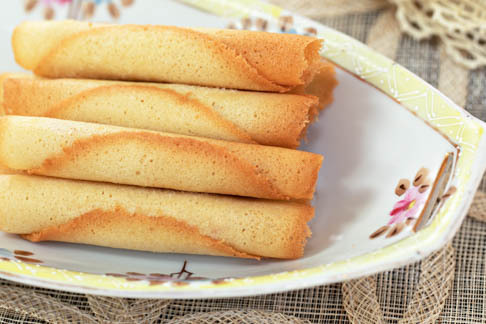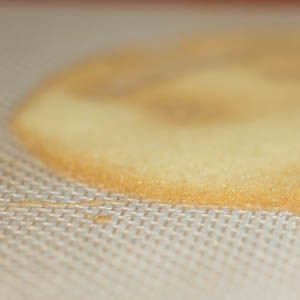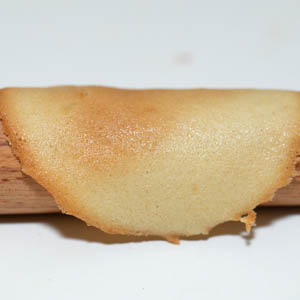Cigarette Wafers

introduction
You might recall a brief encounter with these cookies when they were lounging around a restaurant dessert looking gorgeous. Or maybe one summer you saw them out on the terrace sitting elegantly with a coupe of ice cream. So thin and delicate, they looked like they could be French. Want to get to know them better? We’ll arrange an introduction.
The remarkably thin, crisp wafers called tuiles are made from a hand-stirred batter that is thin and stretchy enough to be stenciled onto a sheet pan and baked. Pulled from the oven within minutes when their edges brown, the wafers will succumb to a baker’s deft fingers and take a number of pleasing shapes while they are hot—fluted bowls, curved roof tiles, cigarettes. The formula’s high proportion of egg whites relative to butter, flour, and sugar makes the batter fluid enough to spread with ease, the hot cookies malleable enough to shape, and the cooled wafers uncannily crisp, with a delicate snap. Butter, usually a major player in a cookie recipe, takes a minor role here—just enough for flavor and color. The burnt sugar, butter, and vanilla scents that issue from the oven as the cookies bake smell as captivating as those hovering over a European street fair.
No matter how the cookies are shaped, they are commonly called tuiles, “tiles” in French, because in their simplest form, created by molding the cookies over a cylinder such as a rolling pin, they resemble curved roof tiles. We, however, have chosen to roll the wafers into batons, commonly called “cigarettes” when they take this form. Make them to accompany Butterscotch Pots de Crème and use them in lieu of a spoon.
Baking Notes
Please pull the hard white nubs (chalazae) off the egg whites before weighing them.
This paste performs best if it is not too cool. It can be refrigerated and rested after mixing but return it to room temperature or warm slightly over a warm water bath before stenciling.
A rigid plastic lid about 8 inches in diameter can be used to create a round stencil on which to spread the batter. Using sharp scissors, cut away the lip of the lid to make a nice, flat round of plastic. With a fine-tip permanent marker and a 3½- to 4-inch round cookie cutter, trace a circle on the center of the plastic round; there should be a generous band around the perimeter. Cut out the circle with a pair of scissors, then scrub it thoroughly to remove any remaining ink.
A silicone mat—yes, it’s essential. The wafers will bake fine on plain parchment, but will cool too quickly to shape. If you have more than one silicone mat, work ahead with stencil and paste, but bake only one pan (two tuiles) at a time.
The relationship between tuile and baker does become more complicated throughout the process. It may, for instance, take you a few attempts to gauge how thickly the paste should be spread on the stencil. Too thick and the baked cookie will not be delicate enough; too thin and the cookies will crack when rolled. The best weight is 0.4 to 0.5 ounces per wafer—not more. A regular teaspoon (not a measuring spoon) filled generously is about right. If the cookies cool too much before they’re shaped, return them briefly to the oven to soften.
To roll cigarettes, slide a sharp, thin metal spatula under a round, flip it over so the shiny side is up, then roll it around a ¼-inch dowel directly on the silicone mat. Press down on the seam and roll back and forth to seal. The cookie will slide off easily when it has cooled. If forming cigarettes is hell on your fingers, go with basic tuiles.
If making tuiles, slide a sharp, thin metal spatula under the hot, just-baked round, lift it off the silicone mat, and lay the cookie over a slender rolling pin to cool.
Having silica packets on hand to keep the cigarettes or tuiles crisp is helpful. The cookies will keep for several days in a well-sealed container.
equipment mise en place
For this recipe, you will need a digital kitchen scale; a rimless cookie sheet or a rimmed baking sheet; a silicone baking mat or two; a small saucepan; a medium-small bowl; a small whisk; a small offset spatula; a 2½- to 3-inch round plastic stencil (see Baking Notes); a silicone spatula; a regular teaspoon; a small, sharp metal spatula; and a ¼-inch wooden dowel around which to roll the cigarettes or, if making tuiles, a slender rolling pin upon which to drape them.
-
-
1.3ounces clarified butter, barely warm
-
2ounces egg whites, chalazae removed
-
½teaspoon vanilla extract
-
Pinch of fine sea salt
-
2.5ounces sifted confectioners’ sugar
-
1.5
-
-
Adjust a rack to the middle position and heat the oven to 350 degrees. Line a rimless cookie sheet with a silicone baking mat, or, if using a rimmed baking sheet, invert it and lay the mat on the surface.
-
Turn the clarified butter into a medium-small bowl. Add the egg whites and whisk to combine, then whisk in the vanilla and salt. Add the sugar and whisk until well combined. Add the flour and whisk lightly just until smooth. The paste will have a flowing, almost stretchy consistency.
-
Lay the stencil (see Baking Notes) on one side of the silicone mat. Spoon a regular teaspoonful (0.4 to 0.5 ounce) of paste into the center of the stencil. With the tip of small offset spatula (fig. 3.1), spread the paste into an even layer, then cant the spatula and sweep it upwards at the edge of the stencil to remove excess paste. Scrape the spatula against the rim of the bowl to remove excess paste, then scrape down the sides of the bowl with a silicone spatula. Lift off the stencil (fig. 3.2). Form another round on the other side of the silicone mat. Slide the baking sheet into the oven and bake until the cookies have splotchy golden spots and are slightly darker at the edges, 5 to 6 minutes (fig. 3.3); rotate the baking sheet halfway through if the cookies are browning unevenly.
-
Remove the baking sheet from the oven. Immediately slide a small, sharp, thin metal spatula under one of the rounds, then flip it over on the mat. Lay a ¼-inch dowel across the edge of the tuile and tightly roll the cookie around the dowel (fig. 4.1). Press down on the seam and roll back and forth to seal, then slide the cigarette off the dowel. Repeat with the second round. If making tuiles, immediately slide a small, sharp, thin metal spatula under one of the rounds, then flip it over on the mat. Lay the cookie over a slender rolling pin (fig. 4.2), then do the same with the second cookie. Let the tuiles cool, then remove them from the rolling pin.
-
Wipe or scrape the silicone mat and repeat with the remaining paste, continuing to bake and form two cookies at a time until no paste remains. Store the cigarettes in an airtight container with a silica packet or two to keep them crisp. They will keep nicely for several days.
-
-
3.1

-
3.2

-
3.3

-
-
-
4.1

-
4.2

-